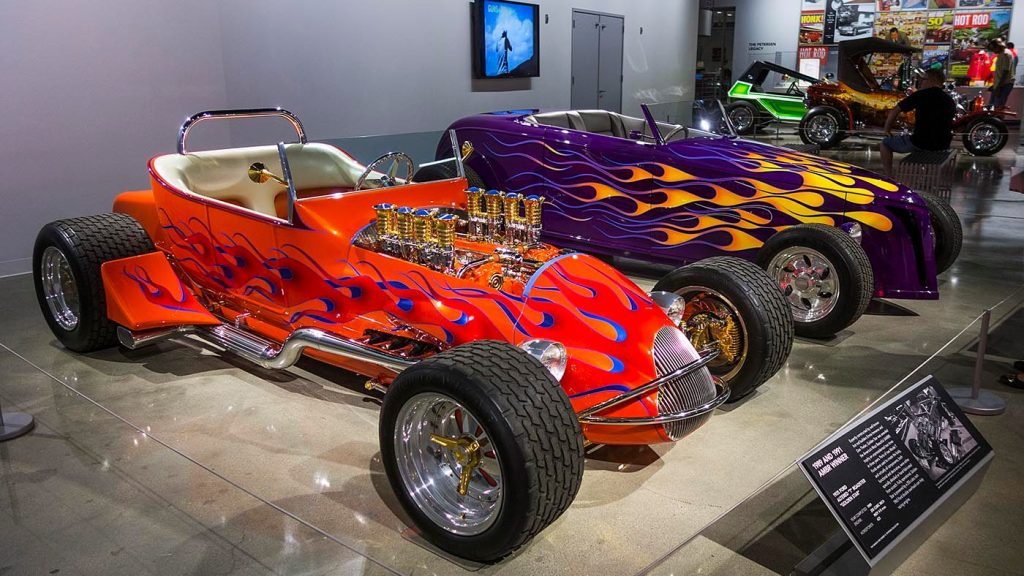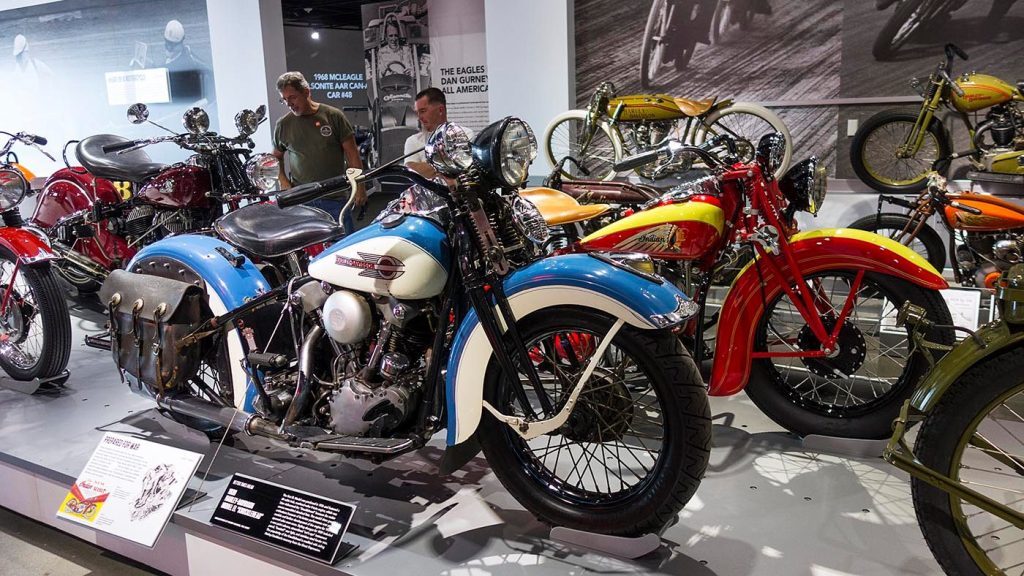After Robert E. Petersen established his legacy with the successful launch of a fleet of car magazines, he built a lasting monument to the automobile in Los Angeles. We visit the renowned Petersen Car Museum.
Los Angeles is arguably the city that loves cars the most so it’s no surprise when you show up at the Petersen Car Museum 15 minutes ahead of its opening time and find people queueing up to enter. That queue only grew longer on the day I visited, so getting there early is recommended if you wish to avoid the crowds and have relatively unhindered access to the 300 vehicles on display daily.
Entry is an affordable 16 bucks (13 if of pension age), and worth the price given that visiting the museum imparts an understanding of how much the automobile is enshrined in the culture of Los Angeles. For a further $20, you’ll be guided into the depths of the building to view the other 300 vehicles that aren’t on display in the vault. However, the over-reaching control of the guides, the stifling unconditioned atmosphere, and the fact that cameras must be left upstairs, makes the vault visit an experience that can only be enjoyed by the most hardcore automotive historians.
Upstairs is therefore where the real highlights of the Petersen Car Museum are to be found. Here’s my personal list of the things that rightly rank the Petersen amongst the world’s best automotive museums.

The Legacy
Robert E. Petersen first published Hot Rod magazine in 1948, and in doing so legitimised an outlaw sub-culture, making it acceptably mainstream. The instant success of the magazine soon allowed him to broaden his business horizons, and he launched Motor Trend just one year later in 1949. These would soon be followed by many more specialist titles. Petersen and wife, Margie, then decided to celebrate the role of the car in popular culture by opening the museum in 1994.
The Wilshire Boulevard venue in downtown LA used to be Ohrbach’s department store, and was chosen because its windowless architecture would allow cars to be displayed without the degrading effects of direct sunlight.
Petersen died in 2007, and when Margie also passed away in 2011, the Margie & Robert E. Petersen Foundation gifted the property and many of the vehicles on display to the Petersen Automotive Museum Foundation, along with $US100 million in cash. In 2015, the museum underwent an extensive $US125 million renovation, where a new stainless steel ‘ribbon’ façade was added, and 25 galleries created inside it.
The revised interior design allowed for vehicles to be easily rotated between the galleries and the vault. The museum is also infamous as the site of the murder of rapper, The Notorious B.I.G., who was fatally shot in his SUV as he left a party at the museum in 1997.

Harleys vs Indians
Each of the museum’s 25 galleries usually has a theme, and one of the most compelling during my visit showcased the rivalry between Harley-Davidson and Indian. It certainly made a nice change from usual museum fodder like the extensive hall dedicated to the work of Ettore Bugatti, and his genius designer and eldest son, Jean.
The rivalry between the motorcycle company from Springfield, Massachusetts, and the one from Milwaukee, Wisconsin, was as fierce as any between Ferrari and Lamborghini, and when one discovered a new niche in the market, the other soon followed suit. The Petersen displays the way each covered the other’s moves by putting the rival products side-by-side. For example, the survivors of deadly board track races of the 1920s from each brand sit handlebar-to-handlebar.
Showing off the two most important bikes from either brand, the first overhead-valve Harley, the 1936 EL ‘Knucklehead’, sits directly adjacent to the 1933 Indian Scout that was the only pre-war model still in production when Indian first went belly-up in 1953. It was a rivalry that even extended to four wheelers, as a pair of three-quarter midget Speedway racers powered by V-twins from the rivals shows.
The Eagles have landed
Dan Gurney may have started the motorsport tradition of spraying champagne after a successful race but he also helped build and refine some of the most gorgeous race cars ever created through the team he started, All-American Racers. The Petersen allows you to get up and close and personal with three of these. There’s the infamous ‘McLeagle’ Can-Am car that Gurney had built out of a McLaren M6D customer car in 1968, after failing to trip up ‘the Bruce and Denny show’ over the previous two seasons.
Gurney retained the McLaren’s aluminium monocoque frame but built his own suspension arms out of titanium and switched the V8 engine from a big-block Chevy to a small-block Ford stretched to its absolute limits by Harry Westlake. It proved a wasted effort. Hulme, McLaren (both in new M8As), and Mark Donohue (racing a M6B for Roger Penske) made it a 1-2-3 finish for McLarens in the championship that year. Gurney finished a lowly 15th. The Offenhauser-powered 1968 Indy Eagle was far more successful, finishing 1-2 in the Indy 500 that year, with Gurney tucked well into the draft of winner, Bobby Unser, when the chequered flag fell.
While the Offy-Eagle will rightly be remembered as the most successful AAR car, the 1967 Eagle-Westlake V12 F1 racer is arguably the prettiest of all. Gurney won a rain-soaked Belgian Grand Prix with it in one of the few GPs where the Westlake V12 held itself together for the entire race.
America’s ‘Space Age’ conceps
If you’ve read Popular Mechanics magazines from the 1950s, you’d recognise many of these wacky n’ wild concept cars from that era. The Petersen displays those that made it all the way to motor shows, some that made it into production, and many that got no further than the drawing board. All represent dreams that were never to be realised, like the 1948 Davis Divan, with its concealed headlights, four-abreast single seat, tricycle wheel layout, and aluminium body construction. Just 16 were of these 135km/h oddities were made and sold for $995.
The 1947 Salsbury Scooter could have become America’s Vespa for the way it enclosed all the oily bits with aerodynamic bodywork and presented a cleaner ride than the motorcycles of the day. Less than 1000 of E. Foster Salsbury’s creations were made, and the $400 price made a Davis Divan appear an absolute bargain. Equally intriguing are all the concept drawings from the era on display – rocket cars mounted on monorails, and stuff suitable only for an episode of the Jetsons. They were all a reminder that the world’s most creative school of automotive design, the famous Art Centre College in Pasadena, is just a short drive from the museum.
Automotive Movie Mania
So too is Hollywood and the Petersen celebrates the local movie industry through props like the Delorean from Back to the Future, and the full mock-ups of the animated vehicles from the Cars franchise, along with the original storyboards used by the animators. A James Bond DB5 is a must-have for any self-respecting car museum, and the Petersen’s is from Skyfall.
But perhaps the most impressive display is a Yamaha V-Max-based camera-carting sidecar, which gives a hint of the danger faced by many camera crews when getting that essential car chase footage. It was used by those working on Terminator 2, Judgement Day, and True Lies. Could it be the maddest Max of all?
Rods n’ Riders
Cruise the streets of Los Angeles on a warm summer’s night, and you’ll see gatherings of hot rods, rat machines and lowriders all over the place. The Petersen celebrates the role custom machines have played both in its own creation and honours many of its famous sons while doing so.
There’s the 1932 Ford Roadster the ‘Boydster II’ that Overhaulin’ star, Chip Foose, originally created as his homage to the late Boyd Coddington in 1996. Then painted yellow, it won the coveted America’s Most Beautiful Roadster (AMBR) prize at the Grand National Roadster Show that year. Foose then revised the car in 2000, restyling it slightly and painting it black. It won the same title again that year.
Among other AMBR winners at the museum is the 1937 Ford-based Alien, by Art and Mike Himsl, which somehow adds a dune buggy appearance to a roadster. Meanwhile, fans of custom paint schemes will have their eyes popping at all the lowriders on display at the Petersen.
My fave is El Rey (the King), a 1963 Chevrolet Impala, reimagined by Albert De Alba over six years after he inherited the car from his deceased father-in-law. Such is the place that El Rey holds in lowrider culture that it has been voted lowrider of the Year for three years in a row.
Viewing the beautiful painted and engraved Impala is like seeing some masterpiece in the Louvre, and the car has been exhibited all over the world at events like the Essen Motor Show and Japan’s Classic Legends. It’s a car that celebrates the city of its birth – brash, bright, big, and colourful.


